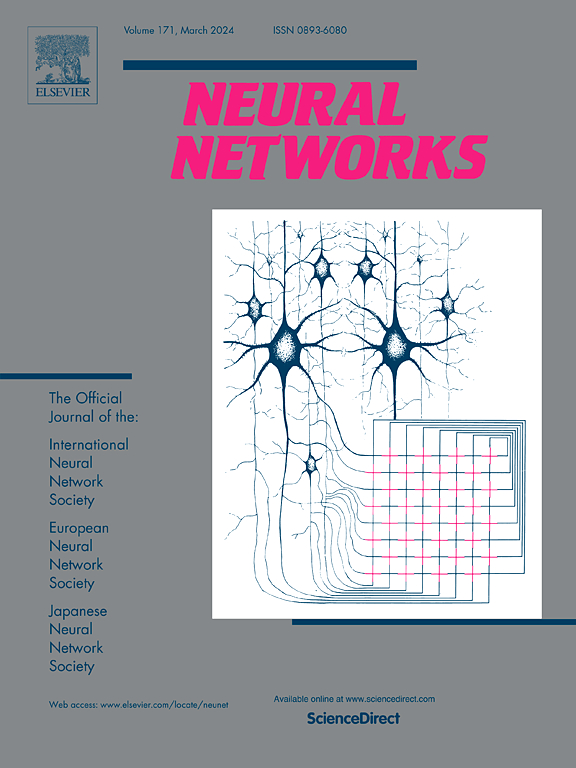Real-time fine finger motion decoding for transradial amputees with surface electromyography
IF 6
1区 计算机科学
Q1 COMPUTER SCIENCE, ARTIFICIAL INTELLIGENCE
引用次数: 0
Abstract
Advancements in human-machine interfaces (HMIs) are pivotal for enhancing rehabilitation technologies and improving the quality of life for individuals with limb loss. This paper presents a novel CNN-Transformer model for decoding continuous fine finger motions from surface electromyography (sEMG) signals by integrating the convolutional neural network (CNN) and Transformer architecture, focusing on applications for transradial amputees. This model leverages the strengths of both convolutional and Transformer architectures to effectively capture both local muscle activation patterns and global temporal dependencies within sEMG signals.
To achieve high-fidelity sEMG acquisition, we designed a flexible and stretchable epidermal array electrode sleeve (EAES) that conforms to the residual limb, ensuring comfortable long-term wear and robust signal capture, critical for amputees. Moreover, we presented a computer vision (CV) based multimodal data acquisition protocol that synchronizes sEMG recordings with video captures of finger movements, enabling the creation of a large, labeled dataset to train and evaluate the proposed model.
Given the challenges in acquiring reliable labeled data for transradial amputees, we adopted transfer learning and few-shot calibration to achieve fine finger motion decoding by leveraging datasets from non-amputated subjects. Extensive experimental results demonstrate the superior performance of the proposed model in various scenarios, including intra-session, inter-session, and inter-subject evaluations. Importantly, the system also exhibited promising zero-shot and few-shot learning capabilities for amputees, allowing for personalized calibration with minimal training data. The combined approach holds significant potential for advancing real-time, intuitive control of prostheses and other assistive technologies.
经桡骨截肢者细指运动的表面肌电图实时解码
人机界面(hmi)的进步对于增强康复技术和改善肢体丧失患者的生活质量至关重要。本文提出了一种新颖的CNN-Transformer模型,通过集成卷积神经网络(CNN)和Transformer架构,从肌表电(sEMG)信号中解码精细手指的连续运动,重点研究了在桡骨截肢患者中的应用。该模型利用了卷积和Transformer架构的优势,有效地捕获了sEMG信号中的局部肌肉激活模式和全局时间依赖性。为了实现高保真的表面肌电信号采集,我们设计了一种柔性和可拉伸的表皮阵列电极套(EAES),它符合残肢,确保舒适的长期磨损和强大的信号捕获,这对截肢者至关重要。此外,我们提出了一种基于计算机视觉(CV)的多模态数据采集协议,该协议将表面肌电信号记录与手指运动的视频捕获同步,从而创建一个大型标记数据集来训练和评估所提出的模型。考虑到桡骨截肢者在获取可靠的标记数据方面的挑战,我们采用迁移学习和少射校准方法,利用非截肢者的数据集实现精细手指运动解码。大量的实验结果表明,该模型在包括会话内、会话间和主题间评估在内的各种场景下都具有优异的性能。重要的是,该系统还为截肢者展示了有前途的零射击和少射击学习能力,允许使用最少的训练数据进行个性化校准。这种结合的方法在推进假肢和其他辅助技术的实时、直观控制方面具有巨大的潜力。
本文章由计算机程序翻译,如有差异,请以英文原文为准。
求助全文
约1分钟内获得全文
求助全文
来源期刊

Neural Networks
工程技术-计算机:人工智能
CiteScore
13.90
自引率
7.70%
发文量
425
审稿时长
67 days
期刊介绍:
Neural Networks is a platform that aims to foster an international community of scholars and practitioners interested in neural networks, deep learning, and other approaches to artificial intelligence and machine learning. Our journal invites submissions covering various aspects of neural networks research, from computational neuroscience and cognitive modeling to mathematical analyses and engineering applications. By providing a forum for interdisciplinary discussions between biology and technology, we aim to encourage the development of biologically-inspired artificial intelligence.
 求助内容:
求助内容: 应助结果提醒方式:
应助结果提醒方式:


